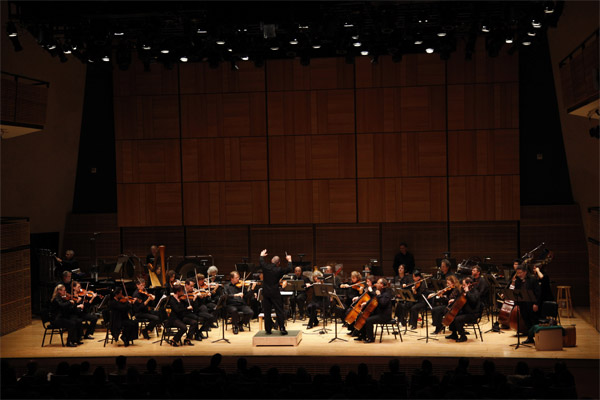 The Sonic Festival opened with five solid new compositions performed by the American Composers Orchestra to a nearly full crowd at Zankel Hall Friday Oct. 14th. What stood out in each piece was the unique and cohesive style of each composer. Each explored new sounds, but without the formulaic approach often employed in new orchestral works (you know…a section of minimalism, a section of Penderecki-style string effects…etc.).
The Sonic Festival opened with five solid new compositions performed by the American Composers Orchestra to a nearly full crowd at Zankel Hall Friday Oct. 14th. What stood out in each piece was the unique and cohesive style of each composer. Each explored new sounds, but without the formulaic approach often employed in new orchestral works (you know…a section of minimalism, a section of Penderecki-style string effects…etc.).
Christopher Stark’s …and start west, for example, began with a sort of off-kilter Broadway-tune style, but with jagged punctuations interrupting. Stark’s imaginative use of percussion, brass, and woodwinds created an industrial sound – harking back to futurist compositions of the 1920s, but updated for this century. The composer’s intent to take the listener on a journey of musical landscapes from NYC through the Midwest and ending in the Rockies was a success. The city sounds immediately energized the concert hall. The pastoral middle section, while evoking Copland, explored new sounds with more jagged and jolting qualities. Stark’s sonic landscape was ultimately more in line with what Kanye West said: “you know what the Midwest is? – young and restless.”

Andreia Pinto-Correia’s Elegia a Al-Mu’tamid was one of those pieces you could just sit back and take in a range of sounds presented with clarity and mystery and the same time. The thin orchestral texture was a bold move by Pinto-Correia, and allowed the new sounds she presented to sit there for the listener to take in. Ethereal dissonances in the woodwinds were particularly stark and breathtaking. A short melodic theme traded around to different solo instruments gave a unity to the work while exploring diverse sounds. While too many new compositions these days feel like a barrage of “innovation” ad nauseum, Pinto-Correia’s composition stood out for the ways its musical ideas and texture were presented effortlessly with time to be digested.

While I am often skeptical of current attempts to fuse popular folk styles with art music – having heard one too many such compositions that just sounded contrived – Kenji Bunch’s use of bluegrass style and techniques on the viola in The Devil’s Box came off as genuine, full of heart, and taking folk ideas to a higher level of artistry. Bunch’s viola playing fused Julliard training, experience playing with bluegrass musicians in Kentucky, and putting emotion at the core of the music. The Devil’s Box was also effective as a programmatic work, exploring how the fiddle was deemed the devil’s instrument by American religious fanatics, with the solo viola interrupting a religious hymn in the first movement. After exploring a variety of bluegrass-style virtuosic playing, including a Cajun bowing style called “the Devil’s elbow,” the viola makes an impassioned plea in the brooding lyrical third movement. The finale brings the interaction between Bunch’s solo playing and the orchestra to a frenzied height.
Above all, this opening night of the Sonic Festival was proof that new music can combine innovation with cohesive musical ideas. The diverse program provided a survey of the 150 composers being presented through the course of the festival. The American Composers Orchestra proved adept in their interpretation of five world premiere performances, and one hopes these works will get performed again soon to further explore each composer’s ideas. Hearing these works was an exciting breath of fresh air and a sense of the possibilities of what is to come.
—
David Pearson is a saxophonist residing in NYC.
























